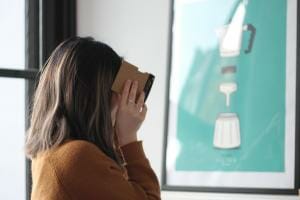The Innovative Ways We Embrace VR During COVID-19
Alley Lyles, Design Producer, USAA

ALLEY LYLES
DESIGN PRODUCER, USAA
During the COVID-19 lockdown, I wandered the streets of Hong Kong, toured the Vatican Museum, and practiced mindfulness in a lush garden. I went “outside” and connected with an Oculus headset.
Virtual reality (VR) is a connector in a world where six-feet social distancing, seeing someone’s face from the eyes up, and meeting co-workers through Zoom is the norm. In a time of disconnection, people are embracing immersive experiences through VR. This artificial environment as a user to accept an immersive experience as a real environment.
Technological developments are changing the ways people experience physical and virtual environments in COVID-19. Leaders in business, education, entertainment, real estate, and mental health extol the value of VR as a highly-interactive and physical-virtual connection. Considering the unique opportunities and benefits VR offers during this pandemic, let’s take a look at five industries that leveraged VR to facilitate connectivity.
Work From Home
As a result of the COVID-19 pandemic, 88% of organizations encouraged or required their employees to work from home. From the onset of the COVID-19 outbreak in the United States, Spatial is enlivening work from home with a VR and augmented reality (AR) experience.
As video conferencing skyrockets, people working from home lament using a two-dimensional screen as a replacement for in-person meetings. Recently, Zoom reached 200 million daily participants (paid and free) up from 10 million in December. With Spatial, two-dimensional meetings are in 3D. The goal is to help users connect in a way that better represents real life.
Many companies — large and small — understand the value of Spatial’s technology during COVID-19. The platform is usable with a VR headset and controllers, or, a laptop computer camera.
As the cost of VR headsets continues to drop and long-term opportunities to work from home grow, this virtual office is likely to remain popular.
College Scouting
GenZ is turning to VR to inform college scouting. As the first real “digital-native” generation, 79% of Gen Z users are comfortable with VR. Today’s high school students use university mobile apps, offering in-app VR experiences, to research campus culture and coursework. Amidst COVID-19, rising high school seniors are “visiting” colleges without leaving the couch. VR may not replace a friendly student-led tour of campus; however, it is presently a viable alternative.

Image by Matthew Kwong
For example, GEAR UP VR for North Carolina provides tours of 16 colleges statewide. Prospective students familiarize themselves with various aspects of students’ life. They can visit dorms, gyms, and cafeterias. They can also learn about degree options, where to apply for financial aid, and what extracurricular clubs thrive on campus. Their virtual visits give them the means to compare universities and find for a good “fit.”
As a silver lining, VR also saves the time and cost of a college visit tour de force. CampusTours, YouVisit, Chicago HBCU Alumni Alliance, YoUniversity, and CampusReel are additional resources that offer VR tours, interactive maps, photos, videos, and current student testimonials.
Catching a Concert
The national COVID-19 lockdowns present a challenge to the entertainment industry and fans. In-person live music performances and movie theater shows remain temporarily suspended as an entertainment option. VR and AR offered alternatives for entertainment consumption beyond video on demand. “The show must go beyond” is the thoughtful slogan of Wave, an immersive platform that transforms artists into digital avatars so we may enjoy a performance in a virtual world. Throw on VR headset and enjoy performances by Tinashe, T-Pain, and John Legend. The experience recreates and augments the sound, excitement, and camaraderie of a concert.
Virtual Real Estate
The pandemic is buckling the real estate industry. Real estate agents are embracing digitization as a means to stay afloat. Chinese startup Beike developed VR to allow potential buyers and renters to view homes on the market. Beike’s traction is undeniable, as 660 million people are leveraging VR to see the 4 million homes on the market.
Additionally, the platform enables homebuyers to sign contracts and complete transactions online without breaking quarantine.
Mining For Mindfulness
Experts report that virtual excursions can help us feel calm and connected amid COVID-19. New research shows that immersive VR videos of a peaceful garden can address various quarantine psychological factors, including stress and isolation. According to Dr. Albert Rizzo, a Director at the Institute for Creative Technologies at the University of Southern California, immersive simulation can be “emotionally evocative” and result in a user’s development of relaxation strategies to cope with anxiety and allow a bit of escapism.
Meditation, coupled with VR technologies, make the mindfulness learning curve easier. Plus, when wearing a headset, you can focus and tune out of any distractions while undisturbed.
Guided Meditation VR, FLOWVR Meditation, and Relax VR: Rest & Meditation are great places to start.

